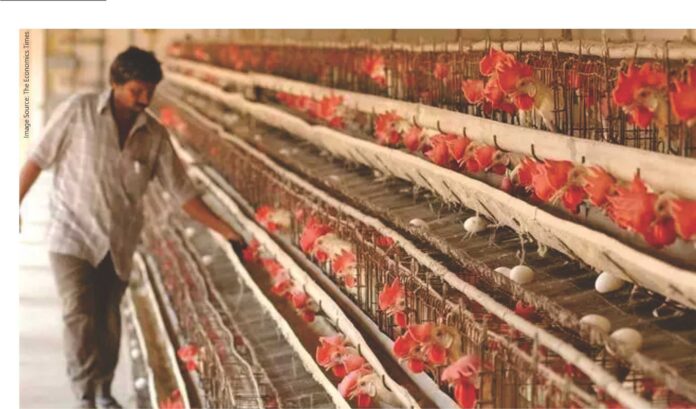

Mr. Ricky Thaper, Treasurer, Poultry Federation of India (PFI) and Honorary Vice President, North India Broilers Producers Association (NIBPA), has been associated with the Poultry Industry for more than three decades and connected to the global poultry community explains key factors behind the growth of poultry industry and challenges ahead in the expansion of the industry in an e-interview with Think Grain Think Feed.
Would you please share a brief policy review for the Indian Poultry Sector?
The Indian poultry sector, now an integral part of agriculture, has played a crucial role in meeting the protein and nutritional needs of the large population. While the production of crops has been rising at a rate of 1.5-2% annually that of eggs and broilers has been rising at a rate of 6-9% per annum. Over the past two decades, it has evolved into a mega-industry, positioning India as a major global producer of eggs and broiler meat.
The government has been providing support in terms of providing financial incentives as well as taking steps in disease surveillance and curbing outbreaks amongst poultry birds. The Poultry Industry and the Government have been working in close coordination to address the issues in this sector. Under the National Livestock Mission, for the first time, the Central Government is providing subsidies to individuals, shelf-help groups, farmer producers organizations (FPOs), etc., to establish poultry farms with hatcheries.
The financial and technological assistance under the Animal Husbandry Infrastructure Development Fund (INR 15,000 crores have been allocated since 2022) is provided for poultry farms, layer farms with environmentally controlled systems, broiler breeder farms, meat processing and value addition infrastructure, establishment of poultry feed plant. Close to 30 lakh farmers associated with Animal Husbandry and dairy have been provided with Kisan Credit Card facilities for meeting working capital requirements as done for crop growers.
As per our findings of a recent survey with 100 plus feed millers and industry experts, the Indian Feed industry might face the risk of further increase in feed prices while international reports suggest lower feed prices might support the industry. Would you please share your perspective on the present scenario?
Demand for poultry feed in the country has been rising at around 8-10% annually over the last decade. Feed which constitutes around 65-70% of the cost of the production consists of mostly maize and soybean meal (SBM). At present 60% of maize production in India is used as feed, with 47% of maize production going towards poultry and 13% for cattle feed.
However, the rate of growth in poultry meat and chicken production has surpassed the growth in maize and soybean output. To protect the interest of the domestic producers, the major national and regional poultry associations have asked the government to allow imports of GM Maize and Soybean because of the ‘unprecedented increase’ in feed prices.
Major Poultry Associations have written to the Ministry of Fisheries, Animal Husbandry & Dairying, Government of India to allow duty-free maize imports to enable the poultry industry to meet its future requirements. The current basic import duty on maize stands at 50%. Citing concerns over the rising maize consumption in ethanol production, India’s 34.60 million tonnes (MT) of annual maize production is insufficient to meet the requirements of the poultry industry as well as the nation’s food security.
The Indian government wants to focus on poultry product exports, being an industry expert who has been serving the industry for more than 35 years now, what challenges and opportunities do you foresee?
In the fiscal year 2022-23, India exported a notable 664,753.46 metric tons of poultry products, with a total worth of INR 1,081.62 crores (USD 134.04 million) to 64 countries.
However, the current share in India’s global poultry trade must increase from the current level of only 1.2% to at least 10% in the next two decades. Currently India’s primary exports are eggs and egg powder while a very small quantity of poultry meat is also exported to neighbouring countries. In the next decades, the country should focus on exporting more value-added products such as liquid eggs, egg chips, ready to cook and ready to eat products. This requires achieving higher meat production, consumption and adequate feed along with setting a target to increase processing to at least 20-30% in the poultry sector. The country should emerge as a hub of exporters of high-quality, safe and sustainable poultry products.
The Department of Animal Husbandry & Dairying has been taking various initiatives to boost the export. The Department has recently submitted a self-declaration of freedom from High Pathogenicity Avian Influenza. To promote export, the Department has recognized 26 poultry compartments as free from Avian Influenza. On October 13, 2023, on World Egg Day, the self-declaration was approved by the World Organisation for Animal Health (WOAH). The focus should be on modernization in the poultry sector through infrastructure development, upgrading hatcheries, breeding farms, processing units and storage facilities to meet international standards, vet labs, testing labs and cold chains.
What is your take on the antimicrobial resistance (AMR) issue and the role of the Indian poultry and livestock industry in the same?
The Indian poultry industry has seen a paradigm shift as it has moved from backyard activities into major commercial farming. Although the poultry industry brought benefits to the economy as well as providing nutritional security, it has also brought some challenges in terms of antimicrobial resistance (AMR). Most poultry production in India is through integrated farming systems – crop production, livestock, poultry, fisheries, etc. or semi-integrated farming systems (including poultry-fish integrated farming). There is a need for regular documentation of AMR in the poultry industry. The use of antibiotics needs to be regulated and optimized.
by Mr. Ricky Thaper, Treasurer, Poultry Federation of India (PFI)













